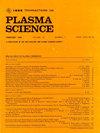Influence of XLPS Roughness on Surface Flashover Characteristics in Vacuum Under Nanosecond Pulses
IF 1.5
4区 物理与天体物理
Q3 PHYSICS, FLUIDS & PLASMAS
引用次数: 0
Abstract
Surface flashover in vacuum is a critical factor restricting the stable operation of the high-power pulsed generators. Cross-linked polystyrene (XLPS) is always used to manufacture typical insulators for power pulsed generators, so it is important to study the surface insulation performance of the XLPS in a vacuum to improve the normal operation performance of the device. Based on the vacuum surface flashover test platform consisting of a solid-state gigawatt-level pulse generator and a test cavity, XLPS samples with a thickness of 13 mm were used to investigate the influence of roughness on the surface flashover characteristics. Samples with roughness of 1.3, 1.7, 2.2, andXLPS粗糙度对纳秒脉冲下真空表面闪络特性的影响
真空条件下的表面闪络是制约大功率脉冲发生器稳定运行的关键因素。交联聚苯乙烯(XLPS)通常用于制造功率脉冲发生器的典型绝缘子,因此研究交联聚苯乙烯在真空中的表面绝缘性能对提高器件的正常工作性能具有重要意义。基于由固态千兆瓦级脉冲发生器和试验腔组成的真空表面闪络试验平台,采用厚度为13 mm的XLPS样品,研究了粗糙度对表面闪络特性的影响。粗糙度分别为1.3、1.7、2.2和2.7~\mu $ m的样品分别在单Hz和10 Hz模式下进行测试。结果表明,两种模式下试样的表面绝缘性能均随粗糙度的增大先增大后减小。利用扫描电子显微镜(SEM)观察了表面闪络事件前后样品表面的微观形貌,分析了微观形貌对电子运动的影响。实验结果的对比分析表明,两种模式下的第一真空表面闪络电压主要取决于表面粗糙度。同时,在10 Hz模式下,前50%闪络电压、条件闪络电压和保持电压均高于单模态,说明重复率脉冲加载条件对试样具有良好的老化效果。
本文章由计算机程序翻译,如有差异,请以英文原文为准。
求助全文
约1分钟内获得全文
求助全文
来源期刊

IEEE Transactions on Plasma Science
物理-物理:流体与等离子体
CiteScore
3.00
自引率
20.00%
发文量
538
审稿时长
3.8 months
期刊介绍:
The scope covers all aspects of the theory and application of plasma science. It includes the following areas: magnetohydrodynamics; thermionics and plasma diodes; basic plasma phenomena; gaseous electronics; microwave/plasma interaction; electron, ion, and plasma sources; space plasmas; intense electron and ion beams; laser-plasma interactions; plasma diagnostics; plasma chemistry and processing; solid-state plasmas; plasma heating; plasma for controlled fusion research; high energy density plasmas; industrial/commercial applications of plasma physics; plasma waves and instabilities; and high power microwave and submillimeter wave generation.
 求助内容:
求助内容: 应助结果提醒方式:
应助结果提醒方式:


